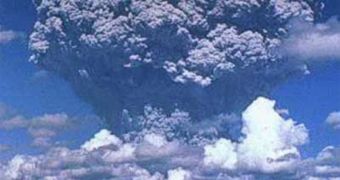The Krakatoa eruption may have been just a child play compared to the volcanic megablast that spread havoc in the human civilization around 536 AD. Its volcanic cloud could have triggered a global chill that caused famine in half of the world's population. An international research published in the journal "Geophysical Research Letters" has found sulphates, molecules representing marks of an eruption, in Greenland ice.
This is the first physical evidence for the A.D. 536 event, which according to ancient texts from Mesoamerica, Europe, and Asia, brought on a cold darkness that doomed crops, triggered wars, and boosted disease spread. The debate was whether the disaster had been caused by a volcano or an asteroid clashing with Earth.
"There is no need at the moment to invoke a large-scale extraterrestrial event as the cause, because the evidence is conclusive enough to say that it is certainly consistent with it being a large volcano," said co-author Keith Briffa of the University of East Anglia in the United Kingdom.
The ice Greenland sulphates were found to have been deposited between A.D. 533 and 536, matching a sulphate maximum level encountered in Antarctic ice. As the volcanic ash reached both poles, this means that the blast is likely to have occurred near the Equator. Other proofs are delivered by tree rings from the Northern Hemisphere, revealing lower growth rates for over a decade around year 536. But the cooling effect was not encountered in the southern hemisphere, too.
The data shows that this eruption was even more powerful than the biggest historically recoded volcanic eruption, that of the Indonesian Mount Tambora (2,865m or 9,550ft tall) from the Sumbawa Island. On the 10th of April, 1815, the mountain blew out, ejecting its peak into the atmosphere at a height of 1,250m (4,160ft)! The cataclysm was marked with 7 on the Volcanic Explosivity Index (VEI) scale (volcanologists classify eruptions, depending on their violence, on a scale from 0 to 8) and at the moment killed 12,000 people. Subsequently, 80,000 people died of hunger. About 150-180 cubic kilometers of debris were projected into the stratosphere, dimming the sky and depriving the Northern Hemisphere of summer.
Asteroid or volcano?
Some still sustain the space impact theory.
"To cement their case, volcano advocates will need to find ash layers deposited by the blast," said Ken Wohletz, a volcanologist at Los Alamos National Laboratory in New Mexico, while the new evidence strongly supports a large volcanic eruption.
Historical texts say that the volcanic cloud lingered for over a year. Chinese historians mention famine events and summer frosts for years following the event. By the same time, a horde of Mongoloid Turkic nomads, the Avars, coming from Mongolia, invaded Europe, founding an empire in central Europe (in today Hungary and surroundings). Probably the nomads were forced out by drought or lack of vegetation growth under the blackened skies in their homeland steppes. Some even put the decline of the Mesoamerican city of Teotihuacan on this. The rise of Islam could have also been favored by this event. Moreover, a similar eruption would cause similar effects today, as we are even more vulnerable than ever. Agriculture would fall worldwide, and transportation and communication systems would be impeded.
"Most aircraft cannot fly in [volcanic] dust clouds. And these dust clouds have a large electrostatic potential that disrupts radio communication," said Wohletz.
And even the technological advances are impotent in impeding such a disaster, or in dwindling its impact.

 14 DAY TRIAL //
14 DAY TRIAL //